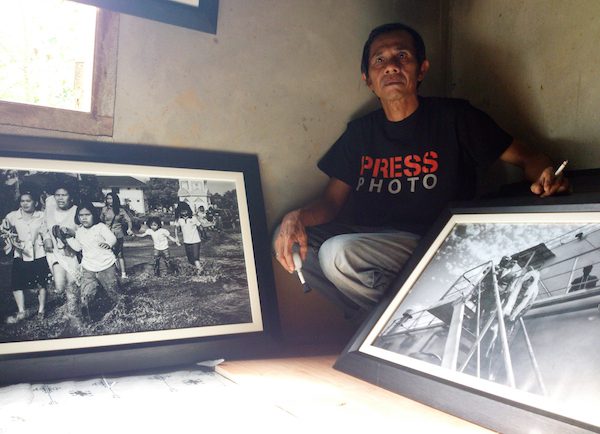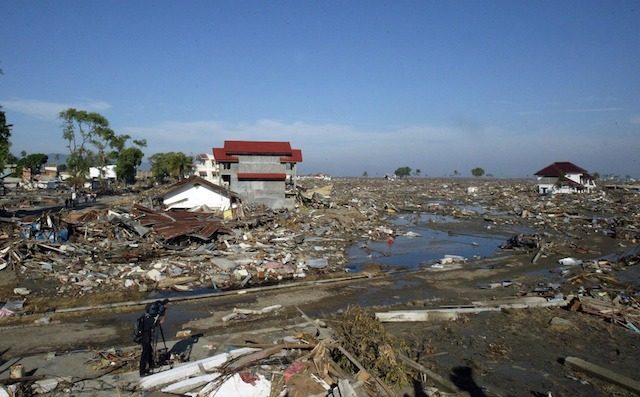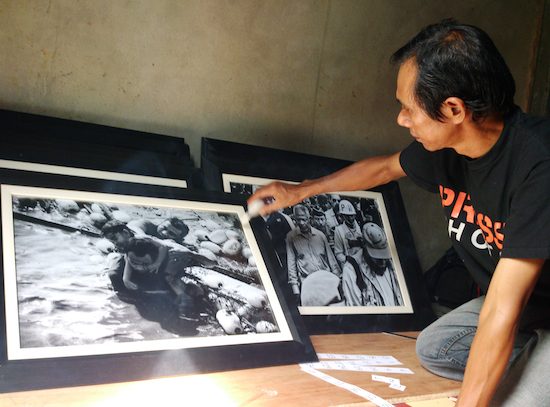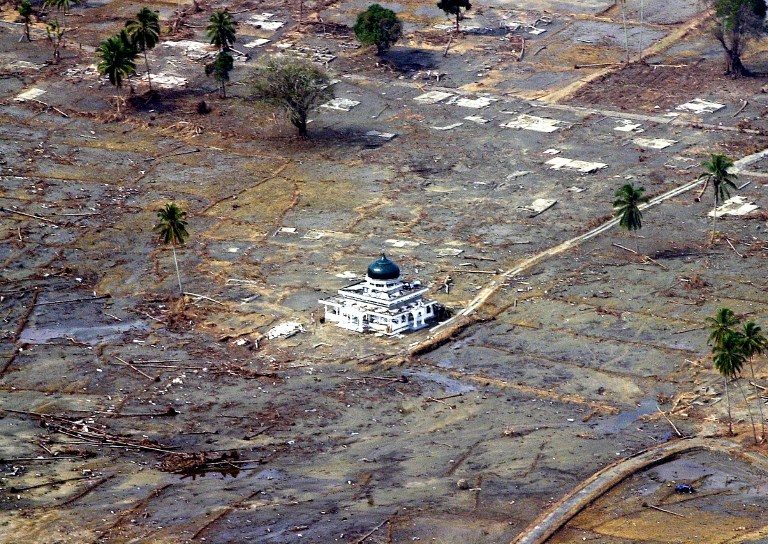SUMMARY
This is AI generated summarization, which may have errors. For context, always refer to the full article.

BANDA ACEH, Indonesia –The 53-year-old photojournalist took a sip of the coffee he bought from a street stall in Banda Aceh. This is how Bedu Saini’s mornings usually start: With a cup of coffee, after taking his children to school, and before he goes out to look for photos for Serambi Indonesia, the newspaper he has been working for since 1990.
After finishing the coffee, he got up to leave. On that Wednesday, he wanted to take photos of the hostage rescue simulation exercise being done by an Indonesian Army unit in Krueng Aceh, a river that runs through the middle of Banda Aceh. To get a good vantage point, he decided to stand on Pante Pirak bridge – one of the most memorable places of his life.
From that same bridge 10 years ago, on the morning of December 26, he photographed two men struggling to bring a toddler to safety amid raging waters brought on by one of the worst disasters in recorded history.
He clearly remembers that particular morning.
When the 9.3-magnitude earthquake shook Aceh, Bedu was safe at home with his wife, their three children and his mother. But his journalistic instincts kicked in and, despite his wife’s protests, he got on his motorbike and headed to the city center to document the damage.
After taking a few pictures of buildings damaged by the quake, he noticed locals running away from what appeared to be water chasing them.
“I kept taking pictures of people running, even though the water was coming right at me. So I went to a higher place to take pictures of the people running away from the tsunami,” he said.
‘I kept taking pictures of people running, even though the water was coming right at me’
Bedu went to the nearby Pante Pirak bridge. From there, he took image after image of people struggling amid raging waters.
The entire time he was photographing the tsunami’s ferocity, he was thinking of his mother, his wife and the three children he left at home. With the water rising, he felt he could do nothing but pray for their safety.

At around 2 pm, when the water began to recede, Bedu immediately hopped on his motorbike to head home. But that proved difficult with all the debris and bodies on the road. Even when he finally reached the area where his rented house was located, the water remained too high for him to pass.
He parked his bike in front of the Zainoel Abidin General Hospital, left his camera at the second floor of a store, and waded through waist-deep water to reach his home.
But when he got there, he was aghast to find it destroyed, his family nowhere to be found.
A neighbor told him his wife was in another neighbor’s house, safe on the second floor. He breathed a sigh of relief and rushed over, grateful to find his wife clinging to his second daughter.
But their eldest, a 6-year-old girl, their youngest, a 4-month-old boy, and his mother were nowhere to be seen.
They did not make it, his wife said.
They spent several days looking, but their bodies were never found.
‘Maybe if I didn’t go out after the earthquake, my two children and mother would not have died’
Recorded history
Even though its office and its printing machines were destroyed, Serambi was able to start printing again a week later, relying on a printing machine in North Aceh. Aceh’s biggest daily lost 55 employees, including 11 journalists, to the tsunami. Those who survived, including Bedu, worked to produce a newspaper using emergency tools.
On January 14, 2005, a little over two weeks after the tsunami, someone dropped off Bedu’s camera at Serambi’s office.
“I thought it had been lost. I went back to the store where I left it, but it was no longer there,” he said.
The next day, Bedu’s pictures of the moment the tsunami struck were on the paper’s front page. Three days later, they were published by national and international media.
In December 2012, on the 8th anniversary of the disaster that changed his life, Bedu held a solo exhibit of his pictures. Thirty-four black and white prints that captured the destruction, the refugees, the emergency response, and the reconstruction were displayed for a week under the theme: “A Day to Remember, December 26, 2004: Tragedy, deaths, tears and prayers.”

Starting out as a janitor
Bedu did not set out to become a photojournalist. When he first joined Serambi, he was a janitor. After 3 years of diligently doing his job, he was moved to the photo lab. For the next 7 years, he manned the dark room, learning about what makes a good photograph from the thousands of films he developed day after day.
When Serambi announced it was recruiting new journalists, Bedu told the editor, Erwiyan Syafri, he was interested in taking the test. “On the condition that if I did not pass, I would not be let go,” he said.
Erwiyan – who perished in the tsunami – gave Bedu a shot. After going through a rigorous selection process, Bedu made it as a photojournalist. He didn’t even have a camera at the time, and had to use a borrowed one until the office bought him his own.
At the height of the separatist conflict between the Free Aceh Movement (GAM) and Indonesian security forces, Bedu found it easy to get a shot that would make it to the paper.
“During the conflict, my most memorable moment was covering a house with GAM members in it that was surrounded by security foreces in Lambuk, Banda Aceh. It lasted almost 5 hours. That was in 2003,” he said. “But if you ask me what the most memorable moment in my entire career as a photographer was? They all are.”
These days, Bedu’s days are less exciting but he gets to spend more time with his family. In the morning, after bringing to school his two children – both born after the tsunami – he drinks coffee with other photographers and journalists. His daughter, the one who survived the tsunami, now lives in a madrasah or Islamic boarding school. Every weekend, he and his wife would visit her.
After finishing his coffee, he would go out and look for photographs. In the afternoon, he would pick up his kids from school. Between dusk to evening, he would be at the office editing photographs.
The images he took of the day the tsunami came are stored, not displayed, and he would rarely look at them if he did not need to. It still pains him to remember the tragic day, he said.
“Maybe if I didn’t go out after the earthquake, my two children and mother would not have died,” he said. “But Allah has decided everything, and I accept it.” – Rappler.com
This is part of a series of photo essays and features Rappler Indonesia is running throughout the month of December to mark the 10th anniversary of one of the deadliest natural disasters in recorded history.
Add a comment
How does this make you feel?
 IN PHOTOS: When the tsunami devastated Aceh
IN PHOTOS: When the tsunami devastated Aceh
There are no comments yet. Add your comment to start the conversation.